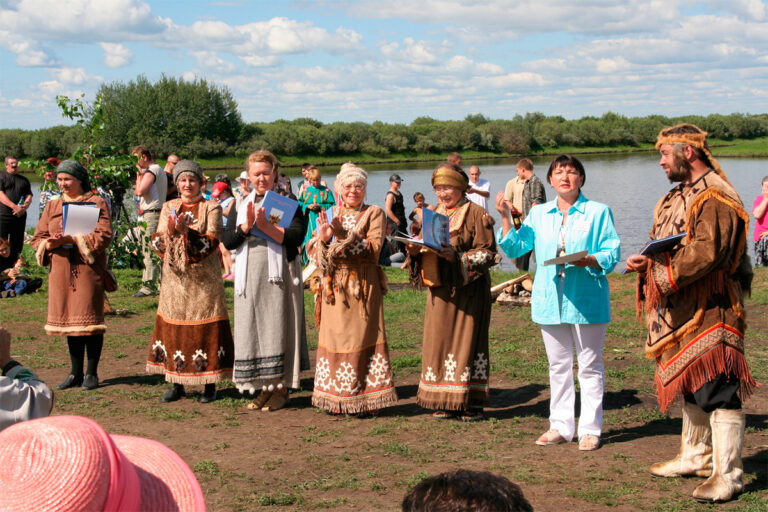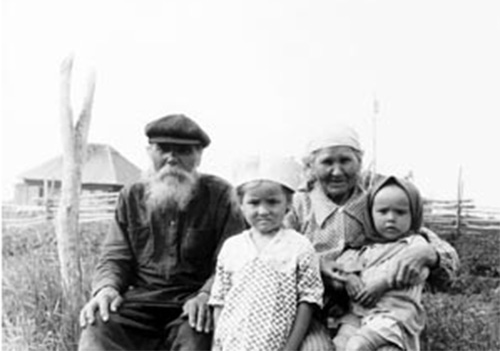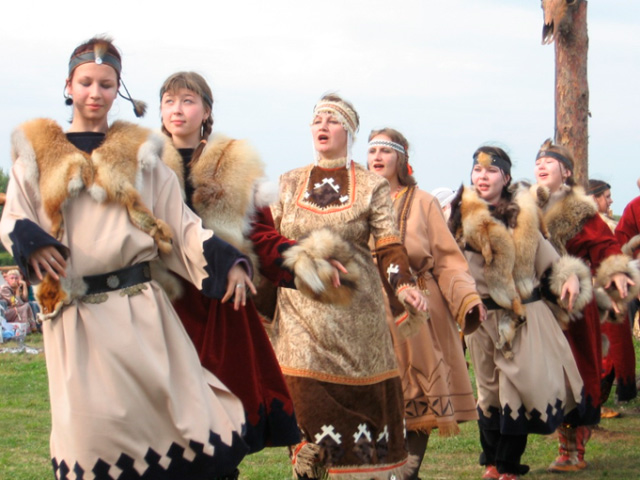Selkups

THE HISTORY OF THE ORIGIN OF THE PEOPLE
Selkups - one of the indigenous people of Russia. The Selkups are divided in two groups - the Northern (self-designation - selkup, sheolkup ("forest man") and the Southern (self-designation - chumylkup ("ground man"), syussae-kum, shyeosh-kum ("taiga man").
The Northern Selkups are located on the territory of Yamalo-Nenets Autonomous Area (Krasnoselkupsky and Purovsky districts) and in the north of Krasnoyarsky territory (Turukhansky district). The Southern Selkups live in the north of Tomsk Region (Kolpashevsky district, north of Parabelsky and Kargasoksky districts). The obsolete name of the northern Selkup is Ostyako-Samoyeds. The name "Selkups" was introduced by the linguist and ethnographer G. N. Prokofiev in the 1930s.
According to the 2010 Census, the number of Selkups living in the Yamalo-Nenets Autonomous Area includes 1988 people.
Before the annexation of Western Siberia to the Russian state (XV century), the Selkups lived on the territory of the middle reaches of the Ob and its tributaries. In the XVII century, part of the Selkups were displaced from the specified area by other peoples and moved to the Taz River, and later to Turukhan, where, mixing with the Kets and Ents, they formed a group of northern Taz-Turukhan Selkups who mastered reindeer husbandry. Their final ethnic formation as an ethnographic group was completed in the XIX century. Part of the village was assimilated by Turkic groups (Tomsk Tatars) and Russians. Until recently, the Selkups consisted of separate tribal groups, not related to each other geographically or economically.
The division of the Selkups into two territorial groups and their contacts with neighboring peoples are recorded in the peculiarities of ethnic culture. The southern Selkups are now significantly assimilated by the Russian population and have lost many elements of the taiga hunting and fishing economic and cultural complex characteristic of all peoples living in the taiga zone of Western Siberia.
The northern Selkups, in contact with the North Samodian peoples, as well as the Kets and Evenks, have mastered taiga transport reindeer husbandry and to this day retain traditional commercial farming, mobile housing, traditional clothing for Northerners, food regimes, utensils, transport, continue to exist some functions of traditional social institutions, the foundations of the traditional worldview.
Source: https://www.tomsk.ru/news/view/
LANGUAGE
Selkup language is related to the Samoyed branch of the Uralic language family. It is believed that the Selkup language separated from its closest relatives – the Nenets Tundra, Nenets forest, Enets and Nganasan languages, as well as the now extinct Kamasin and Mator languages - about two thousand years ago. In terms of sound composition, the Selkup language is close to the Kondinsky dialect of the Mansi language and the dialect of the forest Nenets. The Selkup language has four main dialects: northern, central, eastern and southern. Selkups from different regions may not understand each other, use different self-names, but the boundaries between adverbs are vague.
Unlike other Samoyed languages, the Selkup language has a rich vocalism (25 vowel phonemes and 16 consonants).
WRITTEN LANGUAGE
In the early 30s of the XX century, G.N. and E.D. Prokofievs developed the Selkup alphabet based on Latin graphics. A Selkup primer was compiled, and a number of biblical texts were translated. In these books, the Russian alphabet was used without changes and additions.
In 1937, the Selkup alphabet, like the alphabets of all other peoples of the North, was translated into Cyrillic. It included all the letters of the Russian alphabet, also а’, нг, о’, оа, у’, э’. However, soon the publication of books in the Selkup language was discontinued. For a long time, the language was virtually unwritten, although various alphabet designs were proposed. In the late 1980s, education in the Selkup language in schools and the production of textbooks resumed. Now there are two Selkup alphabets – for Northern Selkups (Yamalo-Nenets Autonomous Area) and Southern (Tomsk Region).
Source: https://www.tomsk.ru/news/view/
TRADITIONAL FARMING
Traditionally, the Selkups led a semi-sedentary lifestyle and, based on the peculiarities of natural conditions, gave priority to hunting or fishing.
Hunting. The main object of fur hunting in the taiga is a squirrel. Northern Selkups extract Arctic foxes using traps and wooden traps - mouths. Of the artiodactyls, the objects of hunting are elk in the taiga, and wild deer in the tundra and forest tundra, mainly with the help of a gun. Modern hunting is developed mainly in the north of the Selkup region. The leading place in commercial hunting is occupied by the extraction of waterfowl and upland fowl.
Fishery. Fishing, which is the basis of life support for the population living in the basin of the Ob River and its major tributaries, was carried out by nets, tackles, gigs, muzzles, wicks, automatic snares. In the spring, fishermen jointly blocked the mouths of river tributaries with locks. The main prey is muksun, shchekur, pike, ide, etc. A dugout boat made of cedar or aspen was used as a water vehicle.
Reindeer husbandry. Reindeer husbandry is widespread only in the northern area of settlement of the Selkups, in the Tazovo-Turukhansk region. Reindeer husbandry was borrowed by the Selkups from the Nenets and Ents. Summer free grazing of deer was combined with the use of "deer houses" with smoke-holes.
Under the influence of the Russians, the Selkups (mainly the southern group) began to engage in gardening, breeding domestic animals – horses, large and small cattle, pigs, poultry. The traditional complex of occupations (including reindeer husbandry) is preserved today only among the northern group of the people.
Источник фото: https://travelask.ru/articles/selkupy-unikalnyy-narod-sibiri
TRADITIONAL DWELLING
The traditional dwelling for the southern Selkups since ancient times is a log dugout or semi–dugout (karamo) with a log frame and walls made of planks, covered with birch bark and covered with soil. For heating, a large sack – hearth with a pipe was used.
Later, under the influence of neighboring peoples (Russians, etc.), a log house – blockhouse became widespread. The Northern Selkup reindeer herders used a conical Nenets-type chum covered with deer skins. In the summer, the coating was birch bark, by now tarpaulins are more often used. Currently, Selkups living in large settlements and who have largely lost the features of traditional culture, often settle in standard-plan houses made of timber and covered with iron, slate, etc.
CUISINE
The basis of the Selkup diet since ancient times is fish, which is consumed in boiled, dried and salted form, it is also fermented with berries (cranberries, cranberries, cloudberries) or grind into flour porsu. Fish oil was harvested for the winter. Meat food is of great importance – meat of elk, deer, hog and waterfowl.
Vegetable raw materials complemented the main – meat-and-fish food ration. Flatbreads were baked from barley flour ("myrsa") and sarana ("togul"), and their own bread wine ("ul") was prepared. Wild onions, locusts, and various forest berries are eaten from wild plants. Jam was made from berries without water and sugar. Pine nuts were harvested in the taiga zone. Tea replaced the infusion of juniper, dried raspberries and currant leaves were also used.
A hoppy drink was prepared from juniper, adding young fly agarics to it. There are prohibitions on eating meat of many animals and birds – bear and swan (as creatures close to man), as well as hare, partridge, wild geese, etc. Since the XIX century, the diet of the Selkups has included purchased products – bread, tea, sugar, cereals, butter, since the XX century – meat of domestic animals and gardening products.
CLOTHING AND FOOTWEAR
Winter clothing for men and women of the northern Selkups served as a swinging fur coat of the park made of deer skins, sewn with fur outside. On top of it, in severe frosts, they put on deaf clothes with a sokui hood, sewn with fur outside, borrowed from the Nenets. Under the park, men wore body shirts and trousers made of suede made of deer or elk skin (rovduga), and women wore homespun dresses. Winter shoes for men and women were pymes made of camus or cloth, with calves made of camus. Russian boots have become widespread as summer shoes (in the past, summer shoes were made of fish skin). The winter headdress was a fur bonnet (made of the skins of fawns, arctic foxes or squirrel paws), in summer women wore scarves tied in the form of a kerchief or turban. Among the southern Selkups, Russian-style clothing has become widespread.
RELIGION
The traditional beliefs of the Selkups were animism and shamanism. The world of the Selkups consisted of three layers – heavenly, earthly and underground, and the heavenly and underground were divided into seven more parts. The heavenly world was inhabited by the supreme deity Num, the underworld was inhabited by dead and evil spirits (the ruler of evil Kyzy). Num controls the weather, the fertility of the earth, can send diseases to people. All the elements had spirits, the mistress of the forest lived in the forest, a water spirit lives in every lake, every river.
The Selkups especially revered fire, believed that the mistress of fire lived in it. Therefore, the fire must be handled carefully, it must be fed with the same food that they ate themselves. There are many prohibitions associated with fire among the Selkups, for example, you can not burn garbage and leftovers in the fire, you can not throw "unclean" objects into the fire and dry them over it, you can not swear at the fire. If the fire was treated disrespectfully, he could get angry and punish.
The shaman was of great importance in the Selkup society. He not only performs the functions of a healer and fortune-teller, but also takes an active part in the traditional funeral rite. At the moment, traditional beliefs are mostly preserved among the northern group of people..
FOLKLORE
Selkup folklore is represented by legends (tentyl), fairy tales (chapta), riddles (nurkytsa) and jokes-sayings. In traditional folklore, the narrative of all kinds of adventures of the hero, about his encounters with evil spirits (masters of the elements). Despite all their cunning in the fight against man, evil spirits are always defeated. The legends of the Selkups tell about the wars that the ancestors waged with the Nenets and Evenks; the southern Selkups have preserved legends about the wars with the Tatars. According to these legends, the allies of the Selkups are the Kets and Khanty. The folklore of the Selkups contains many indications of old, long-obsolete beliefs and cults associated with them.
Of musical instruments, there was a harp – a bone lip (made of deer horn) plate with a vibrating tongue, a seven–stringed harp - swan. Both of these tools are common among the southern Selkups. In the north, only the shaman's tambourine was known.
LITERATURE:
- Antonov, Igor Yurievich. Social norms of the peoples of the Far North : a monograph / I. Y. Antonov. – Moscow : UNITY : Law and Law, 2008. – 333, [2] p. ; 21 cm. – Bibliography in footnotes. – 2000 copies. – ISBN 978-5-238-01375-6. – Text : direct.
- Archaeological antiquities of Mangazei in the Krasnoselkupsky Museum of Local Lore /Krasnoselkupsky Regional Museum of Local Lore. – [B. M. : B. I.], [200?]. – 29 p. : photo. color. ; 30 cm. – Text : direct.
- Babakov, V. G. Territorial and tribal communities of the Ob Ugrians and Narym Selkups (XVII-XIX centuries) : abstract of the dissertation for the degree of Candidate of Historical Sciences / V. G. Babakov ; editorial board : executive editor : I. G. Dobrodomov [et al.]. – Moscow, 1973. – 24 p. – Text: direct.
- Bataryshkina, Irina. Valuable heritage of Russia / I. Bataryshkina. – Text : direct // Yamal meridian. – 2011. – No. 8. – pp. 80-82. : photo.color.
- Bobrova, A. I. Selkups of the XVIII-XIX centuries. (based on the materials of the Tiskinsky burial ground) : scientific publication / A. I. Bobrova ; Tomsk Regional Museum of Local Lore. – Tomsk : Tomsk University Press, 2007. – 176 p. : ill. – Bibliography : pp. 110-122. – Text : direct.
- Boyakina, O. I. Zorenka : a book for additional reading in grades 1-2 of Selkup schools / O. I. Boyakina, S. I. Irikov, A. A. Khozova; artists: L. A. Ivanov, N. E. Tsiolik ; editor V. G. Rakhtilin. − Leningrad : Prosveshchenie, branch, 1989. − 159 p.: tsv. il. – Text : direct.
- Russian Russian and Russian-Selkup Dictionary / V. V. Bykonya, A. A. Kim, Sh. Ts. Cooper ; Tomsk Regional Department of the Ministry of Nationalities and Regional Policy, Tomsk State Pedagogical Institute. − Tomsk, 1994. − 94 p. – Text: direct.
- Bykonya, V. V. Sheshkuy primer: for the 1st grade of Selkup schools / V. V. Bykonya, A. A. Kim, Sh. Ts. Cooper. − Tomsk : Tomsk Pedagogical Institute, 1993. − 92 p. : ill. – Text : direct.
- In the land of the Selkups : Krasnoselkupsky district : nature, people, economy, ecology / authors : V. V. Bakulin, K. F. Shcheglov and others. – Yekaterinburg : Sredne-Uralsky Book Publishing House, 2000. – 277, [2] p. : ill., M.maps, port., table. ; 23 cm. – Bibliography : p. 276278. – 1000 copies. – ISBN 5-7529-0028-X (in the lane). – Text : direct.
Articles









